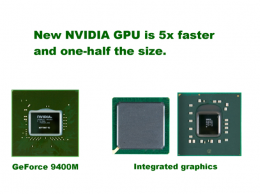NVIDIA Introduces New Integrated GeForce 9400M GPU

Demand for better visual computing performance continues to grow as more and more applications tap the massively parallel processing power of the graphics processing unit (GPU) for more than just graphics. As gamers, video enthusiasts, designers, and now creative professionals require optimized PC solutions, the NVIDIA GeForce 9400M GPU brings a 5x performance increase over integrated core-logic to today's sleek notebook designs.
“Today marks a flashpoint for users around the world,” said Jeff Fisher, senior vice president, GPU business at NVIDIA. “With this new GPU, NVIDIA is able to expand its market footprint from gamers and design professionals to the creative generation of users, as well as firmly establish us at the heart of the fastest growing PC market—the notebook PC.”
Apple has adopted this GPU for its new Apple MacBook, MacBook Pro, and MacBook Air.
The NVIDIA GeForce 9400M is a single chip, high performance, highly integrated design that is ideal for notebooks and smaller computing devices. It features 16 parallel processing cores that deliver a whopping 54 GFLOPs of processing power, making it the most powerful integrated GPU on the market today. It also delivers up to 5x faster graphics performance than Intel Centrino 2, and long-lasting battery power, allowing consumers to watch a complete, full-length HD movie on a single charge.
Provided by NVIDIA





















